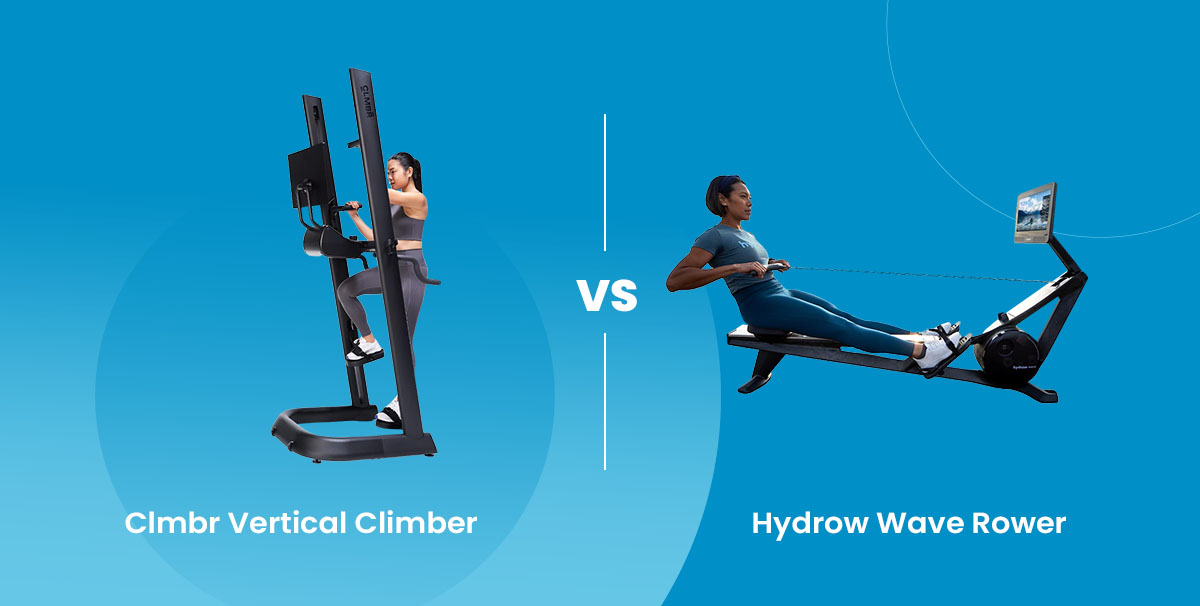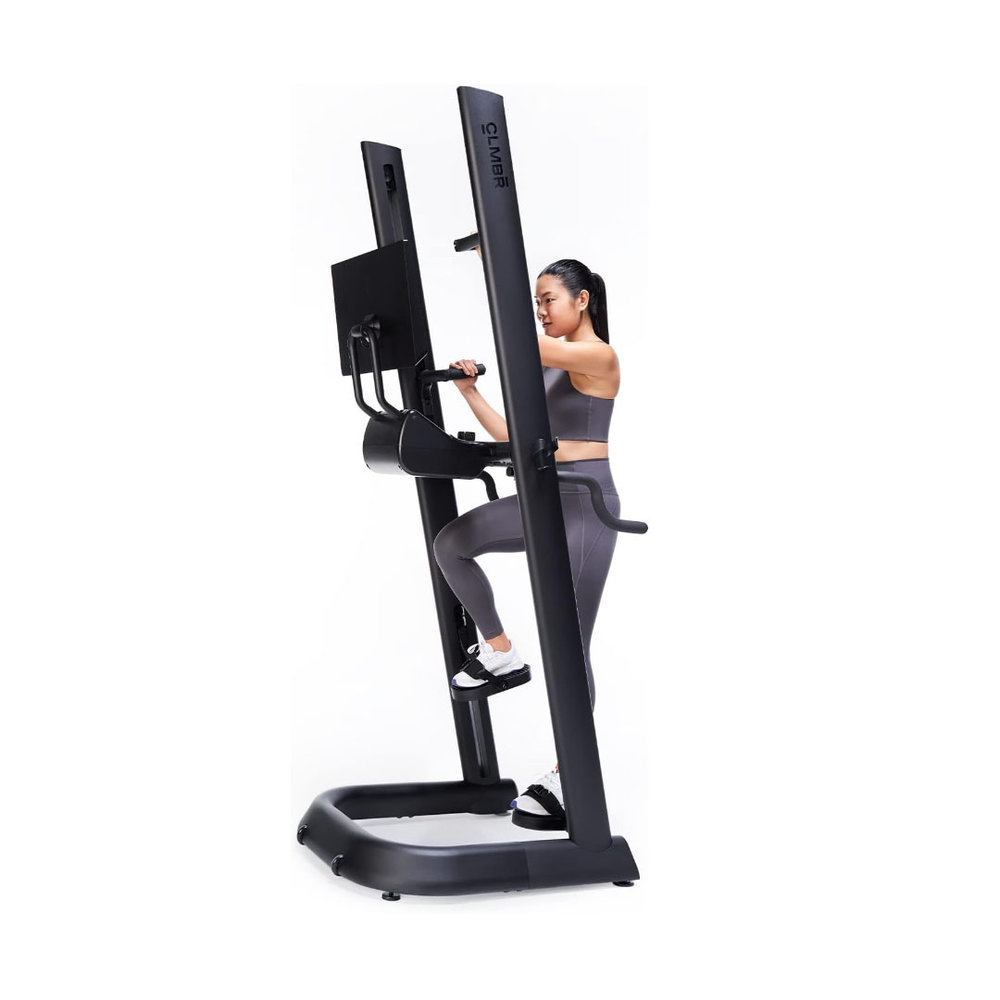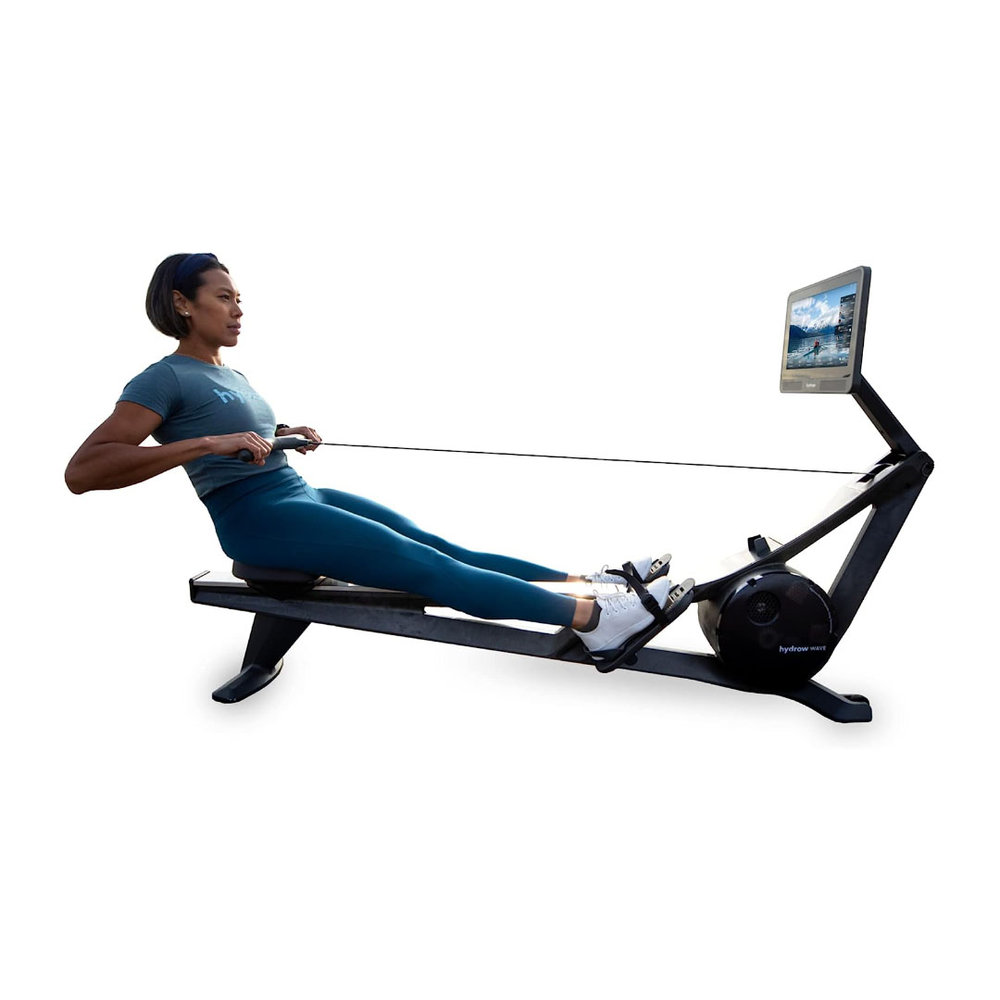We earn a commission if you make a purchase, at no additional cost to you.
If you’re looking for a full-body workout, you might be torn between a vertical climber and a rowing machine.
Is one better for you than the other? Some key differences between a vertical climber and a rower are their weight capacity, calories burnt, storage, electronics, and price.
Let’s dive into the comparison to find the perfect fit for your fitness journey!
Quick Verdict
When it comes to overall calorie burn and full-body workout, vertical climbers seem to have an edge. They engage multiple muscle groups simultaneously, including the legs, core, and upper body, leading to a higher calorie burn and increased cardiovascular endurance.
Clmbr Vertical Climber
We earn a commission if you make a purchase, at no additional cost to you.
The Clmbr vertical climber is a fitness machine that mimics the motion of climbing a mountain or rocky cliff.
It features two pedal-like platforms for the feet and two handgrips for the user to hold onto as they climb.
The machine is specifically designed to provide a complete and comprehensive workout for the entire body, focusing on strengthening the muscles in the legs, arms, back, and core.
It offers adjustable levels of resistance, making it suitable for individuals with varying fitness levels.
It comes equipped with a digital display that shows essential metrics such as time, steps taken, and calories burned.
The Clmbr vertical climber is also compact, making it easy to store when not in use. It is made of durable steel for a solid and sturdy feel during use.
The Clmbr vertical climber is an excellent choice if you’re looking for an efficient, full-body workout that can be done in the comfort of your own home.
Pros:
- It burns calories quickly, making it a great choice for losing weight.
- Compact and easy to store when not in use.
- It mimics the motion of mountain climbing, adding an element of fun to your routine.
- Affordable and easy to use.
Cons:
- Keeping your balance while in use can be difficult, especially for beginners.
- Limited range of motion, as you can only move up and down.
- Not suitable for those who suffer from joint pain or have limited mobility.
Benefits of a Vertical Climber
The vertical climber is a great choice if you’re looking for a compact and relatively reasonably priced solution for a full-body workout emphasizing muscle toning.
You can get a great cardio workout plus strengthen and tone your arms, legs, back, and abdominals all at the same time with this machine.
More than that, it adds excitement to your workout by mimicking the motion of climbing a mountain or rocky cliff.
Are Vertical Climbers Effective?
Vertical climbers provide a full-body workout that can be highly effective if done correctly.
The machine is designed to target not just the arms and legs but also the back and core muscles. When used in conjunction with other cardio exercises, it can help you reach your fitness goals faster than doing activities like running alone.
Adding resistance and varying the speed of your cardio routine can make a vertical stair climber even more effective.
Plus, because it’s compact and the price is reasonable, it’s an ideal choice for those who want to work out at home without breaking the bank.
Hydrow Wave Rower
We earn a commission if you make a purchase, at no additional cost to you.
The Hydrow Rower is a top-of-the-line rower with all the features you need for an effective full-body workout.
With its heavy-duty frame and intuitive interface, this machine can be used by both beginner and advanced users. It also offers water resistance for an additional challenge.
The machine has adjustable resistance, a full-motion seat, and a handle to provide a realistic rowing experience.
The design incorporates a sleek, modern aesthetic built for durability and stability. Hydrow also has WiFi connectivity and can be used with popular fitness apps for tracking progress and setting goals.
Pros:
- Low-impact and easy on the joints.
- A full-body workout that targets all major muscle groups.
- Adjustable resistance for different levels of intensity.
- On the machine, the resistance can be adjusted.
- WiFi connectivity for tracking progress and setting goals.
- Compact and easy to store when not in use.
- The machines are very durable.
- Can offer a HITT training option.
Cons:
- Not all popular models can fold up for easy storage.
Benefits of a Rowing Machine
Rowing machines provide a low-impact workout that can benefit people of all fitness levels. They work the arms, legs, back, and core muscles and provide an aerobic exercise that helps to build cardiovascular endurance.
Are Rowing Machines Effective?
Yes, rowing machines are highly effective for cardiovascular fitness and overall muscle development. They provide a low-impact, full-body workout that targets various muscle groups, including the legs, core, back, and arms.
Vertical Climbers vs. Rowing Machines: What’s the Difference?
| Feature | Vertical Climber Machines | Rowing Machines |
|---|---|---|
| Body position | Upright | Sitting down |
| Price | $100-$300 | $400-$1300 |
| Calories burnt | 600 cal/hr | 900 cal/hr |
| Storage | Foldable | Cannot be folded |
| Electricity | Does not need electricity | Electrical outlet required |
There are many similarities between vertical climbers and rowing machines, as both are full-body workouts that target the arms, legs, back, and core muscles. However, there are some key differences between the two.
Specifications
The Vertical Climber provides a high-intensity, low-impact workout and adjustable resistance, allowing users to change the resistance level according to their fitness level.
On the other hand, the rower provides a low-impact, full-body workout with resistance from water or air. The rower is also a compact and adjustable machine, making it suitable for a variety of different-sized people.
Full-Body Workout
The Vertical Climber is excellent at providing a whole exercise by working on your arms, legs, back, and core.
Although the rower also provides a full-body workout, the intensity you’d get from a vertical climbing machine could not be comparable to the rower’s low-impact nature.
Great for Burning Calories
In terms of calorie burning, the vertical climber usually comes out on top due to its higher intensity, potentially burning up to 900 calories per hour.
The rowing machine is also effective for calorie burning, but the total amount depends on your workout intensity.
Overall, the vertical climber holds a slight advantage in calorie burning.
Nevertheless, both machines offer fantastic workouts and can help you achieve your fitness objectives.
Durable
Both the vertical climber and rowing machine are strong and long-lasting. They are made from tough materials that can handle everyday use.
Thanks to its steel frame construction, the vertical climber stands out for its exceptional sturdiness. Meanwhile, rowers are typically made from aluminum or composite materials, ensuring lasting performance.
Warranty
When considering a vertical climber or a rowing machine, it’s important to review the warranty terms included with each product, as they can vary in terms of time and coverage.
For the CLMBR vertical climber, a 1-year comprehensive warranty is provided after the date of delivery, covering any manufacturing defects in material or workmanship.
In the case of the Hydrow Rower, a five-year warranty is offered for the frame, and a one-year warranty is provided for components (such as the handle, strap, and seat), touchscreen, and labor.
Additionally, if you’re unsatisfied with your purchase, there’s a 30-day return period during which you can request a full refund.
FAQ’s
Can you build muscle with a vertical climber?
A vertical climber can be used to build muscle. It targets all major muscle groups in the arms, legs, back, and core.
Is a vertical stair climber better than a rowing machine?
Both the vertical climber and rowing machines are effective equipment for burning calories and building muscle.
However, the vertical climber is more intense and can burn up to 900 calories per hour, while a rowing machine may provide a different intensity.
How effective is the rowing machine as a cardio machine?
Rowing machines are effective cardio machines because they provide a low-impact workout and can be adjusted to different levels of intensity, allowing you to adjust the resistance according to your fitness level.
Is a vertical climber good for the glutes?
A vertical climber is a great piece of equipment for targeting your glutes.
The machine targets all major muscle groups in the arms, legs, back, and core, including your glutes.
Additionally, because the vertical climber provides a high-intensity full-body workout, it can help you burn calories faster and builds muscle strength more quickly.
Are indoor rowing machines suitable for all fitness levels?
Yes, indoor rowing machines are suitable for users of all fitness levels, from beginners to experienced athletes. The resistance can typically be adjusted to match the user’s ability, providing a tailored workout experience.
How much space do indoor rowing machines require?
The amount of space needed varies depending on the specific model, but most indoor rowing machines require a space of approximately nine feet by four feet, ensuring that you have adequate space for the machine and for moving comfortably around it.
What’s the verdict?
When it comes to overall calorie burn and full-body workout, vertical climbers seem to have an edge. They engage multiple muscle groups simultaneously, including the legs, core, and upper body, leading to a higher calorie burn and increased cardiovascular endurance.
In contrast, rowers primarily focus on the upper body and require less leg engagement, resulting in a lower calorie burn.






